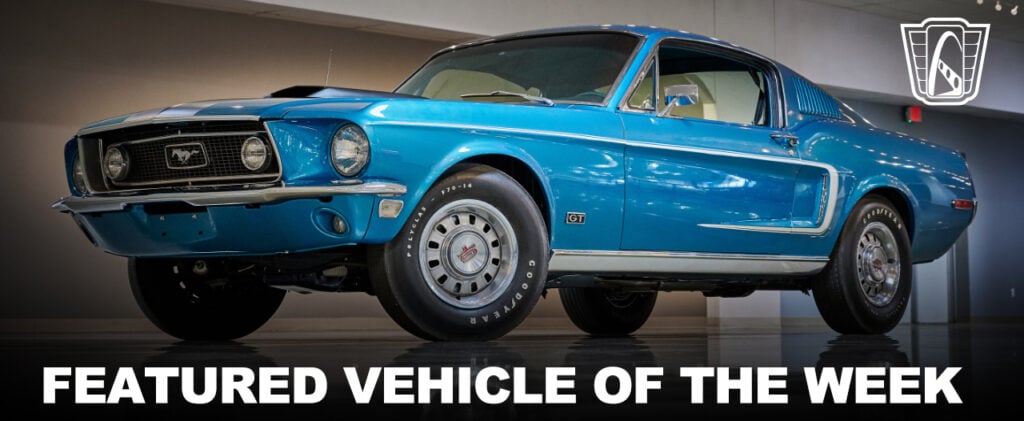
Kimberly V. Althage – April 15, 2022
The Ford Mustang’s charm, regardless of the model year, is their purpose and has remained constant – to master the demands of sportiness and usability. Still in its first-generation, there exists only subtle styling refinements in the 1968 year from the previous. In fact, most of the cosmetic changes were hardly noticeable.
The most obvious change to the 1968 Mustang exterior were the Federally mandated side marker lights. Although, new USA Federal regulations demanded all vehicles have front side markers, Ford went the extra mile and included rear markers as well. Another above and beyond innovative feature was Mustang’s turn signal indicators, which were integrated into the car’s hood by adding them to its recess.
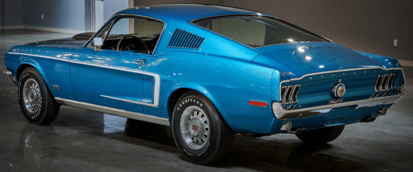
Otherwise, the cosmetic changes were subtle. The deletion of the F-O-R-D letters at the front of the hood for one. The grille was revised, removing the horizontal bars surrounding the galloping pony emblem. Instead, they added a single band around the emblem and a horizontal line connecting the band to the sides of the grille. Lastly, the Mustang’s side scoops were replaced with one-piece chrome styling. The 1968 scoop looked more like a vertical “C” whereas the 1967 looked like air intake openings.
What makes the 1968 model year so special is what might be under the hood. According to advertising of the era, Ford offered the vehicle with a choice of seven engines in 1968. One being a 6-cylinder engine (Code T), and six types of V8 engines (Code C; J; S; X; W; and R). However, the 427ci (Code W) is under debate. It was being phased out of production at the end of 1967. As a result, even though 427 Mustangs were advertised, they could not be ordered at dealerships and there is no proof any of the 427 engines made it into production.
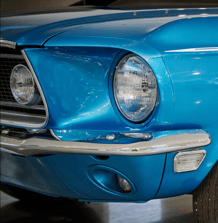
Interestingly the mightier R-Code 428 cubic-inch V8 engine was rated 55 lower in horsepower than the unused 427ci V8. 1968 was the first appearance of the “Super Stock” drag racing Cobra Jet engine. It reestablished Ford as a leader on the dragstrip yet had a lower rating of horsepower on all of Ford’s marketing materials.
Many are familiar with automotive hall-of-famer Bob Tasca Sr. and his contributions to Mustang’s performance and the Ford brand. He was the man who lured NHRA champion John Force away from GM to compete under the Ford banner. Bob has done so many great things for Ford Racing, and the race on Sunday – sell on Monday concept among other things. For purposes of this story, he also helped create the famed 428-cid Cobra Jet engine.
Prior to this era of corporate sponsorship, many of the top drag racing teams in the nation relied on local car dealerships for both financial and technological support. Tasca’s Ford dealership was the second largest in the world at the time. Although examples of dealers’ involvement in motorsports are vast, regarding behind-the-scenes developments and pioneering innovative promotional strategies, none were more influential than Bob Tasca’s in East Providence, R.I.
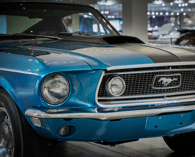
The Cobra Jet origin story began when an employee blew out the engine in Bob’s favorite car. Rather than repair it, Bob instead saw it as an opportunity. Tasca noticed the young had become disenchanted with Ford’s lack of factory performance. He was already compiling sales statistics against Firebirds and GTOs and recognized this lack of performance was costing him sales. He found Ford accounted for only 7.5 percent of all ’66 high-performance vehicle sales and he wanted to find a way to add more muscle to the Mustang. He asked his assistant parts manager Glenn Tiberiis to order a 428 Police Interceptor short block, and to not to say a word about it.
Starting with the 428 Police Interceptor block they ordered, they scavenged the dealership’s Ford parts bin to make improvements. Using a set of modified 427 Low Riser cylinder heads quickly addressed the engine’s inherent “breathing” problems as well as perked up its power of the big FE-series motor. The team tweaked the distributor, advancing the cam three degrees, and installed 427 rocker arms for more lift. After those and other additions, the Frankenstein’d FE engine launched the Mustang to 13-second 1/4 mile at 105 mph, making it better than the very best factory muscle cars that existed at the time.
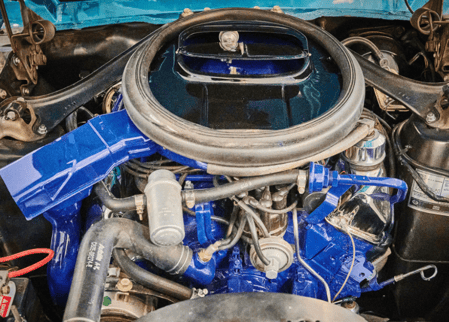
Tasca began offering this souped-up engine through his dealership. His creation was dubbed the Mustang KR-8, for “King of the Road in 1968” and was blazing fast. He brought his KR-8 to Ford’s Dearborn test track in 1967 and beat everything they had. They were so impressed they wouldn’t let it return to Rhode Island. They instead supplied him with a 427 from the Ford GT40 Le Mans program while the engineers picked it apart. Any criticism of tolerance and clearance made were answered with the reminder the 428 short block was a Ford factory part.
Ford’s upper management remained hesitant after the engine was returned to Tasca. The engineers were so impressed they informed Eric Dahlquist from Hot Rod magazine a stop at Bob’s dealership might “prove interesting.” Eric wrote an article about Tasca’s KR-8 in Hot Rod’s November issue, where it contained a ballot readers could send to Henry Ford II to lobby for a new performance Mustang like the KR-8. Upon receiving thousands of positive responses, Ford went to work to put such performance into production.
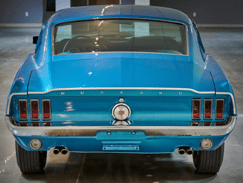
Ford engineers took Tasca’s original creation and developed it further. They started with a relatively mundane 428 block and gave it a parts bin upgrade mostly taken from existing stock as Bob had done with his KR-8. A more aggressive hydraulic lifter 390 GT camshaft was added, and they forged an iron copy of the more expensive aluminum Police Interceptor intake manifold matching it to the bi-port heads. The heads were 427 low-riser style but had larger valves and new cylinder head castings.
Ford’s first usage of a ram-air induction system was fitted with a functional fiberglass hood scoop where a vacuum-actuated butterfly valve directed air into the 735-cfm Holley four-barrel carburetor. Meaning under full throttle acceleration the vacuum-controlled flapper would allow air to bypass the air filter and go directly to the carburetor, yet it would channel air through the filter under normal driving conditions. All of which increased horsepower and engine performance furnishing the engine with cooler air to use during combustion and provided a smooth exit of the burned gases.
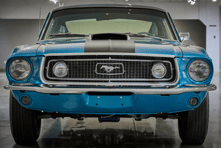
Most were unaware that Carroll Shelby sold his Cobra trademark rights to Ford in 1967 and the company wasted no time utilizing its new purchase as they introduced the 428 Cobra Jet on April 1st. Its output was around 410 horsepower, but Ford rated it at 335hp playing an April Fool’s Joke on the NHRA and insurance agencies alike. Ford reasoned a more “conservative” figure would give them an advantage in AHRA and NHRA classifications. Except the deception did not work as the NHRA factored the 428 CJ into higher classes. Still the Ford Mustang 428 Cobra Jets obliterated everything in their Super Stock class at the ’68 NHRA Winternationals. Yet, Ford never revised their horsepower claims and the 335hp rating stuck right to the end in 1970.
This gorgeous example is 1 of 1,299 Non-Shelby R-Codes and 1 of 1,044 Fastbacks produced in 1968 (2,253 Fastbacks in total for all production years). It is available through our St. Louis showroom, and it comes with the original bill of sale, original title, owner’s manual, first owners ID card, and other service documents that go back to the date of birth of the car. This Gulfstream Aqua beauty has been fully restored to look and drive just as it did when it left Dearborn on July 1, 1968.

If you would like to own your own piece of muscle car history or simply would like to learn more about this very rare 1968 ½ Ford Fastback Mustang GT R-Code, please contact our team in the St. Louis showroom.
Gateway Classic Cars sells and consigns hundreds of vehicles each month. Do you have a classic car for sale with a story to tell? We’d love to hear about it, please email us at news@gatewayclassiccars.com to share it.

Comments